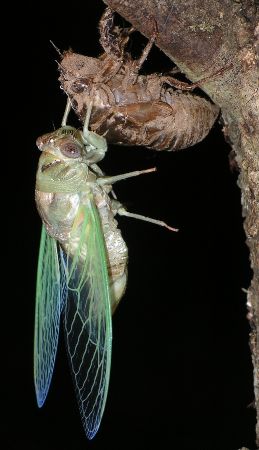by Valerie
July, 2005Annual Cicada
Cicadas are known by several names. They are frequently called locusts, because of their large size and loud calls, but they do not jump and are not related to crickets or grasshoppers. Another name is dog day harvestfly, which is an appropriate descriptor. Mostly, they are just called cicadas, and little distinction is made between species. As a group, cicadas produce some of the loudest insect calls in the world. An Australian cicada is thought to be the absolute loudest in terms of decibels. In North America, our T. resh is among the loudest, especially when giving an alarm call. Besides the alarm sounds, which usually are produced when predators are attacking, the cicadas also "sing" to attract mates. Whole groups of cicadas often sing together, creating quite a loud cacophony of buzzing noises that starts as early as afternoon and lasts into the night. It is sometimes hard to pinpoint just where the sound is coming from in the trees, a useful feature for an insect that is defenseless and edible to a wide variety of creatures. However, I've seen cicada killers (large predatory wasps) home right in on a calling cicada up in a tree. Other animals that prey on cicadas include birds and mammals. Many dogs seem to relish the plump, soft insects. The nymphs of annual cicadas spend one to three years underground, feeding on the juice of plant roots. Once they emerge as adults, they will not eat. The molt from nymph to adult is one of the most frequently seen insect phenomena. The dark brown nymph, usually covered with dirt, will climb out of the ground and up anything nearby, trying to gain as much height as possible before molting. The insect plants its sharply spined legs as anchors and then the skin splits in the back and the light colored cicada slips out of its old shell, hanging still until its wings harden and it dries to the usual dark colors. This most often occurs under the cover of darkness. The insect in the photo is at the point where its wings have just about reached full size, but it hasn't started to darken yet. Because the cicadas have such large bodies, they sometimes have a difficult time getting airborne from the ground. This is why they climb up trees. Another reason for the tree climbing is that is where the female will lay her eggs. During years of heavy cicada infestations, many dead branch tips can be seen on trees where the females have inserted their eggs. This does no harm to the trees and actually acts like a natural pruning mechanism. In years after the hordes of 17-year periodic cicadas emerged when I lived in Illinois, the trees had especially lush foliage. The nymphs drop to the ground as soon as they hatch, to begin their subterranean life. |
 As we head into the infamous Dog Days of summer, what better animal to feature than that ubiquitous harbinger of the season, the annual cicada (Tibicen resh)? Unlike the periodic cicadas, which emerge in great numbers every 13 or 17 years, annual cicadas are usually present every year. They tend to be green or brown colors, but their size varies greatly, from about ½ inch in length to over 1½ inches, with a wingspan of over 4 inches. This particular species is one of three that I've seen in our yard and, as far as I can tell, it has no specific common name.
As we head into the infamous Dog Days of summer, what better animal to feature than that ubiquitous harbinger of the season, the annual cicada (Tibicen resh)? Unlike the periodic cicadas, which emerge in great numbers every 13 or 17 years, annual cicadas are usually present every year. They tend to be green or brown colors, but their size varies greatly, from about ½ inch in length to over 1½ inches, with a wingspan of over 4 inches. This particular species is one of three that I've seen in our yard and, as far as I can tell, it has no specific common name.